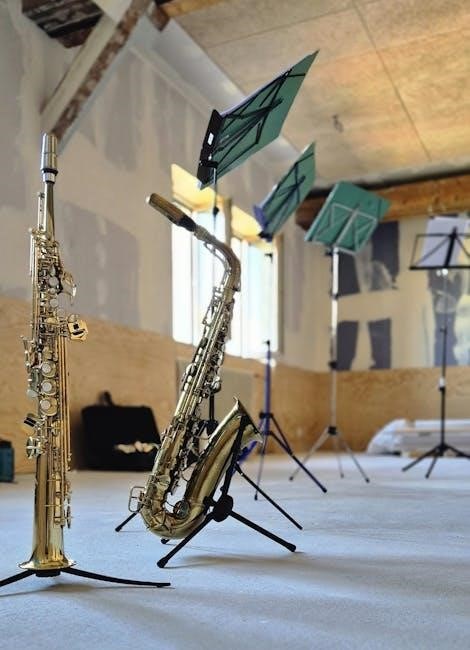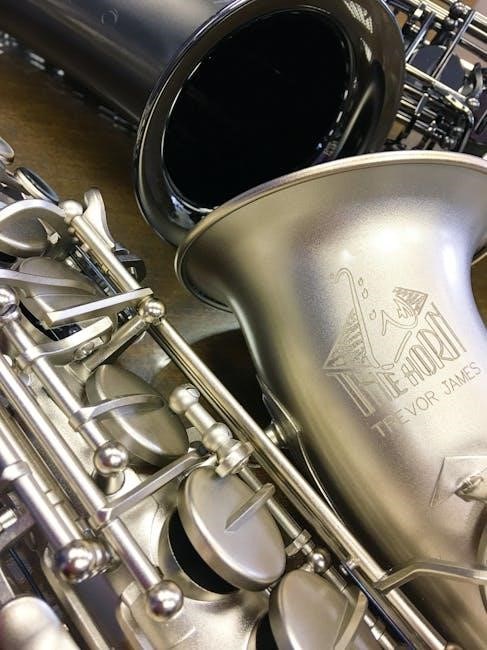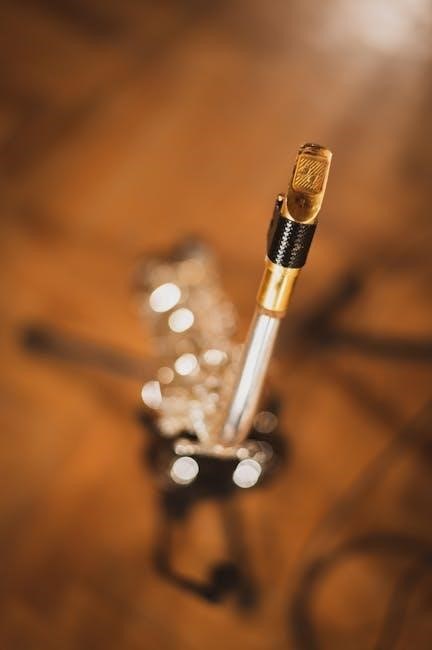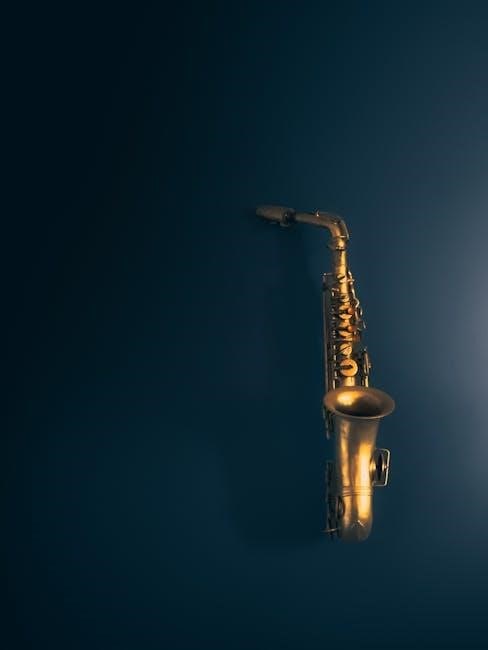Welcome to the ultimate guide on saxophone mouthpieces! This comprehensive resource explores the anatomy, materials, and selection process to help you find the perfect mouthpiece for your sound․
1․1 Importance of the Mouthpiece in Saxophone Playing
The mouthpiece is the heart of the saxophone, directly influencing tone, playability, and overall sound quality․ It serves as the critical link between the player and the instrument, shaping the player’s unique voice․ The material, design, and dimensions of the mouthpiece, such as the tip opening and chamber, significantly impact the sound produced․ A well-chosen mouthpiece can enhance projection, clarity, and responsiveness, while a poor fit can hinder performance․ Unlike reeds, which have a short lifespan, a quality mouthpiece can last for decades, making it a worthwhile investment․ Its importance cannot be overstated, as it plays a more significant role in tone production than the saxophone itself․ Whether for jazz, classical, or other genres, the right mouthpiece ensures optimal performance and sound quality․

1․2 Brief Overview of the Guide
This guide provides a detailed exploration of saxophone mouthpieces, covering essential aspects to help players make informed decisions․ It begins with the importance of the mouthpiece and an overview of the guide․ The anatomy section breaks down key components like the tip opening, chamber, and baffle․ Materials such as hard rubber, metal, and plastic are discussed, highlighting their unique characteristics․ The guide also addresses choosing the right mouthpiece for different genres, tip opening sizes, reed compatibility, and the importance of playtesting․ Budget considerations and popular brands are explored, along with maintenance tips and common mistakes to avoid․ The conclusion offers final thoughts and encouragement to experiment, ensuring players find their ideal sound․

Anatomy of a Saxophone Mouthpiece
The saxophone mouthpiece consists of critical components like the tip, chamber, and baffle, each affecting tone, intonation, and playability․ Understanding its design enhances sound production and control․
2․1 Key Components of a Saxophone Mouthpiece
A saxophone mouthpiece is composed of several essential parts that collectively influence its performance․ The tip opening determines the size of the gap where the reed vibrates, affecting playability and tone․ The chamber shapes the internal airway, impacting the sound’s warmth and clarity․ The baffle, a sloped surface at the chamber’s entrance, influences brightness and projection․ Additionally, the table supports the reed, while the rails guide the ligature․ The shank connects to the saxophone neck, ensuring proper alignment․ Each component’s design and precision contribute to the mouthpiece’s overall quality and the player’s ability to produce desired tones effectively․
2․2 Understanding Tip Opening, Chamber, and Baffle
The tip opening, chamber, and baffle are critical elements that shape the saxophone mouthpiece’s sound and playability․ The tip opening affects volume, pitch control, and air requirement, with larger openings producing brighter tones․ The chamber influences the sound’s warmth and core, while the baffle, a sloped surface, enhances brightness and projection․ A steeper baffle typically results in a brighter sound, whereas a more gradual one yields a darker tone․ These components work together to create a balanced and responsive mouthpiece, allowing players to achieve their desired musical expression․ Understanding their interplay is key to selecting the right mouthpiece for specific genres and playing styles․
Materials Used in Saxophone Mouthpieces
Saxophone mouthpieces are made from hard rubber, metal, or plastic․ Hard rubber offers a wide-spreading sound, metal provides power and projection, and plastic is durable and affordable․
3․1 Hard Rubber (Ebonite) Mouthpieces
Hard rubber, or ebonite, mouthpieces are the most common choice for saxophonists․ They are known for their wide-spreading sound, making them versatile for both classical and jazz settings․ Ebonite mouthpieces are durable and offer consistent playability, with a balanced tone that suits various musical styles․ Many professionals and beginners alike prefer them for their affordability and reliability․ Hard rubber mouthpieces are also less prone to damage compared to metal, making them a practical option for everyday use․ Their adaptability and rich tonal quality ensure they remain a popular choice across genres, providing a solid foundation for achieving a desired sound;
3․2 Metal Mouthpieces
Metal mouthpieces are favored for their powerful projection and bright, vibrant tone, making them ideal for jazz and modern music․ They offer exceptional clarity and a wide dynamic range, allowing for bold expression․ However, metal mouthpieces can be less forgiving for beginners, as they require precise embouchure and air support․ Their durability is high, but they are more expensive than hard rubber options․ Many professional saxophonists prefer metal for its ability to cut through ensembles and deliver a robust sound․ Despite their higher cost, metal mouthpieces are a popular choice among advanced players seeking a strong, projecting tone suitable for demanding musical settings․
3․3 Plastic Mouthpieces
Plastic mouthpieces are a cost-effective and durable option, often recommended for beginners or those on a budget․ They are lightweight and resistant to wear, making them ideal for students or casual players․ Plastic mouthpieces tend to produce a warmer, softer sound compared to metal or hard rubber, which can be beneficial for classical or ensemble settings where subtlety is preferred․ While they may lack the projection and brightness of other materials, their affordability and ease of use make them a practical choice․ Additionally, plastic mouthpieces are less likely to cause discomfort during long practice sessions, making them a great starting point for new saxophonists․
Choosing the Right Mouthpiece for Your Genre
Your genre dictates the ideal mouthpiece․ Jazz often requires brighter, larger-tip openings, while classical favors smaller, darker tones․ Match your style for optimal sound and playability․
4․1 Jazz and Modern Music Mouthpieces
Jazz and modern music often demand mouthpieces with brighter tones and larger tip openings for projection and flexibility․ Popular choices include the Vandoren V16, Jody Jazz HR, and Otto Link Tone Edge․ These mouthpieces offer a medium to bright sound, ideal for cutting through ensembles or delivering dynamic solos․ The Vandoren V16, for instance, provides a neutral yet versatile tone, while the Jody Jazz HR offers a more focused, projecting sound․ Otto Link mouthpieces, known for their inconsistency, can excel when a good specimen is found․ For modern styles, consider the Jumbo Java for extreme brightness․ Each option caters to different playing preferences, ensuring a perfect match for your jazz sound․
4․2 Classical Music Mouthpieces
Classical saxophonists often prefer mouthpieces with smaller tip openings and darker, more focused tones․ The Selmer S80 C and Vandoren Optimum (TL3/TL4/TL5) are popular choices, offering a balanced, refined sound suitable for orchestral and chamber settings․ These mouthpieces provide excellent control and subtlety, essential for classical repertoire․ The Selmer Soloist is another versatile option, blending richness with clarity․ Classical mouthpieces typically emphasize precision and evenness, allowing for nuanced phrasing․ They are designed to complement the ensemble rather than stand out, making them ideal for traditional performances․ Playtesting is crucial to find the right balance of tone and playability for your classical needs․
4․3 Flexible Options for Multiple Styles
For musicians who play across multiple genres, flexible mouthpieces are ideal․ The Vandoren V16 and Jody Jazz HR* series are excellent choices, offering a balanced tone that works well for both jazz and classical settings․ These mouthpieces provide a neutral foundation, allowing reeds and embouchure to shape the sound․ The Selmer Soloist is another versatile option, blending richness with clarity․ Flexible mouthpieces often feature medium tip openings and chamber designs that adapt to various playing styles․ While they may not excel in extreme brightness or darkness, they offer consistency and adaptability, making them a practical choice for players who need to transition between styles seamlessly․ Playtesting is key to finding the best fit for your versatility needs․
Tip Opening Sizes and Their Effects
Tip opening size significantly impacts sound and playability․ Larger openings produce brighter tones and greater volume, while smaller openings offer darker, more controlled sounds․ Proper sizing balances sound quality and ease of play, affecting pitch accuracy and air usage efficiency․
5․1 Understanding Tip Opening Measurements
Tip opening measurements are crucial in determining a mouthpiece’s playability and sound characteristics․ The size of the tip opening, often measured in millimeters, affects the brightness, volume, and pitch accuracy․ A larger tip opening typically produces a brighter, more projecting sound, while a smaller opening yields a darker, more mellow tone․ The measurement also influences the reed’s vibration and the player’s embouchure․ Manufacturers use various numbering systems, with higher numbers indicating larger openings․ Understanding these measurements helps players choose a mouthpiece that aligns with their desired sound and playing style․ Proper sizing ensures optimal performance and comfort, making it a key factor in mouthpiece selection․
5․2 Impact of Tip Opening on Sound and Playability
The tip opening significantly influences both the sound and playability of a saxophone mouthpiece․ A larger tip opening generally produces a brighter, more projecting sound with greater flexibility, often preferred in jazz and modern styles․ Smaller openings yield a darker, more mellow tone, ideal for classical music․ The size also affects reed vibration and embouchure comfort․ Players may find larger openings require more air support and precise embouchure control, while smaller openings offer easier pitch accuracy and subtlety․ Balancing tip opening size with personal playing style and musical genre is essential for achieving the desired sound and comfort․ Proper sizing enhances overall performance quality․

Reed Selection and Mouthpiece Compatibility
Reed strength and mouthpiece compatibility are crucial for optimal sound and playability․ Choosing the right reed ensures proper vibration and tone quality, enhancing your saxophone performance significantly․
6․1 How to Choose the Right Reed Strength
Choosing the right reed strength is essential for achieving optimal sound and playability․ Reed strength, measured on a scale from soft (1) to hard (5), affects tone, responsiveness, and ease of play․ Softer reeds are ideal for beginners, as they are easier to produce sound with, while harder reeds suit advanced players seeking a brighter, more projecting tone․ Consider your playing style, genre, and mouthpiece compatibility when selecting reeds․ Jazz and modern music often favor harder reeds for their vibrant sound, while classical settings may prefer softer reeds for warmth․ Test different strengths to find the balance that complements your mouthpiece and enhances your performance․
6․2 Matching Reeds to Your Mouthpiece
Matching reeds to your mouthpiece ensures optimal performance and tone․ Reed strength and mouthpiece design are closely linked, as the mouthpiece’s tip opening, chamber, and baffle influence how a reed responds․ Softer reeds work better with larger tip openings, while harder reeds pair well with smaller ones․ Reed strength should complement the mouthpiece’s characteristics to achieve the desired sound․ Start with the manufacturer’s recommended reed strength for your mouthpiece and adjust based on your playing style and tone preferences․ Testing different reeds with your mouthpiece is crucial, as reed inconsistency can affect playability and sound quality․ Proper matching enhances responsiveness and overall performance․
Trying Before Buying
Trying before buying is essential to ensure the mouthpiece suits your style and sound preferences․ Visit music shops or borrow from fellow musicians to test options thoroughly․
7․1 Importance of Playtesting Mouthpieces
Playtesting mouthpieces is crucial to ensure they suit your style and sound preferences․ Visit music shops or borrow from fellow musicians to test options thoroughly․ Each mouthpiece feels and sounds different, and what works for one player may not work for another․ The material, design, and tip opening significantly impact playability and tone․ Testing allows you to assess comfort, intonation, and responsiveness․ It’s also a chance to compare how different mouthpieces interact with your reeds and embouchure․ Don’t rush the process—take your time to find the right fit․ Many players recommend testing multiple mouthpieces to identify the best match for your sound and genre․ This step is vital for long-term satisfaction and performance quality․
7․2 Where to Find Mouthpieces for Testing
Locating mouthpieces for testing can be done through various channels․ Visit local music stores or saxophone specialists, as they often provide playtesting opportunities; Online retailers may offer trial periods or return policies, allowing you to test mouthpieces at home․ Additionally, attend saxophone workshops or events where manufacturers showcase their products․ Join online forums or communities, where members often lend or recommend mouthpieces․ Some brands offer in-store trials or rental options․ Networking with fellow saxophonists can also provide access to mouthpieces for testing; Explore these avenues to find the perfect fit for your sound and style․ Testing ensures compatibility and satisfaction before making a purchase․
Budget Considerations
Set a budget and balance quality with cost․ Entry-level mouthpieces are affordable for beginners, while high-end options offer superior performance for professionals․ Test before investing․
8․1 Entry-Level Mouthpieces

Entry-level mouthpieces are an excellent starting point for beginners, offering affordability and ease of play․ Models like the Vandoren 4C and Yamaha 4C are popular choices, providing consistent performance․ These mouthpieces are designed to help develop proper embouchure and technique without breaking the bank․ While they may lack the customization of high-end options, they deliver a solid, reliable sound․ Brands like Rico also offer durable, budget-friendly options like the Metalite, ideal for students or those experimenting with different styles․ Entry-level mouthpieces are a practical investment for those new to saxophone playing, ensuring a smooth transition into more advanced setups as skills improve․
8․2 High-End Mouthpieces
High-end mouthpieces are crafted with premium materials and precise engineering, offering superior tone and playability․ Brands like Vandoren, Otto Link, and Jody Jazz are renowned for their high-quality designs․ These mouthpieces often feature intricate chamber and baffle designs, providing a rich, nuanced sound․ They are typically made from hard rubber, metal, or advanced synthetic materials, ensuring durability and consistency․ High-end options like the Vandoren V16 or Jody Jazz HR* series are favored by professionals for their versatility and ability to produce a wide dynamic range․ While they come at a higher cost, they are a worthwhile investment for serious players seeking optimal performance and customization to their unique style․
8․3 Balancing Quality and Cost
Finding the right balance between quality and cost is crucial when selecting a mouthpiece․ While high-end models offer exceptional performance, they may not be necessary for every player․ Entry-level mouthpieces, such as those from Vandoren or Rico, provide excellent value for beginners or those on a budget․ Mid-range options strike a balance, offering improved features without excessive cost․ It’s important to assess your needs, playing style, and budget to make an informed decision․ Prioritizing key features like tip opening, material, and compatibility with your reeds can help you find a mouthpiece that meets your requirements without overspending․ Quality and cost should align with your musical goals and preferences․

Popular Mouthpiece Brands
Leading brands like Vandoren, Otto Link, and Jody Jazz are renowned for their quality and tone․ Each offers unique characteristics, catering to diverse playing styles and preferences among saxophonists․

9․1 Vandoren Mouthpieces
Vandoren mouthpieces are a top choice among saxophonists, known for their consistency and versatility․ They offer a wide range of models, from the V16 and Java series for jazz to the Optimum line for classical players․ Vandoren’s commitment to quality ensures reliable performance, making them a favorite for professionals and students alike․ Their mouthpieces are designed to pair well with specific reed strengths, which Vandoren clearly outlines, helping players make informed decisions․ Whether you’re seeking brightness, warmth, or a balanced tone, Vandoren provides options to suit various styles․ Their durability and widespread availability make them an excellent starting point for anyone exploring mouthpiece options․
9․2 Otto Link Mouthpieces

Otto Link mouthpieces are legendary for their rich, full-bodied tone and versatility, making them a favorite among jazz and blues saxophonists․ Known for their high-quality craftsmanship, they offer a range of models, such as the Tone Edge series, which delivers a bright, powerful sound․ While Otto Links are highly regarded, they are notorious for inconsistent manufacturing, so finding the right one requires playtesting․ When you discover a well-made Otto Link, it can outperform even the Vandoren V16, offering exceptional tone and playability․ Their unique design and historical significance make them a sought-after choice for musicians seeking a distinctive sound․ Always try before buying to ensure you find a piece that matches your style and preferences․
9․3 Jody Jazz Mouthpieces
Jody Jazz mouthpieces are highly regarded for their exceptional tone and versatility, making them a top choice for saxophonists seeking a bright, modern sound․ Known for their HR and Jet series, these mouthpieces deliver a wide range of tonal possibilities, from medium-bright to very bright․ Jody Jazz is particularly popular among jazz and contemporary players due to their ability to produce a powerful, projecting sound with excellent articulation․ While they are harder to find than Vandoren or Otto Link mouthpieces, their unique design and consistent manufacturing make them worth the search․ For musicians looking to enhance their sound with a modern edge, Jody Jazz offers a superior option that balances playability and tone quality․
Maintenance and Care
Regular cleaning and sanitizing are crucial for maintaining your mouthpiece’s sound quality and longevity․ Use mild soap and water, avoiding harsh chemicals․ Store it in a protective case to prevent damage and scratches, ensuring optimal performance and durability over time․
10․1 Cleaning and Sanitizing Your Mouthpiece
Regular cleaning and sanitizing are essential to maintain your mouthpiece’s performance and hygiene․ Use a mild soap solution and warm water, gently scrubbing with a soft cloth or brush to remove residue and bacteria․ Avoid harsh chemicals or abrasive materials that could damage the surface․ Pay special attention to the chamber and tip opening, where debris often accumulates․ After cleaning, rinse thoroughly and dry with a clean cloth to prevent water spots․ For deeper sanitizing, soak the mouthpiece in a mixture of equal parts water and white vinegar for about 30 minutes․ Clean your mouthpiece after each use to ensure optimal sound quality and longevity․
10․2 Proper Storage and Handling
Proper storage and handling are crucial to maintain your mouthpiece’s condition and performance․ Always store your mouthpiece in a protective case or pouch to prevent scratches and damage․ Avoid exposing it to extreme temperatures or direct sunlight, as this can warp or degrade the material․ When handling, use a soft, dry cloth to wipe away moisture and oils from your skin, which can tarnish metal mouthpieces over time․ Never store the mouthpiece on the saxophone, as this can cause accidental damage․ Keep it in a cool, dry place, away from heavy objects that could crush or bend it․ Regularly inspect your mouthpiece for signs of wear and address any issues promptly to ensure longevity․

Common Mistakes to Avoid
Avoid common pitfalls like buying a mouthpiece without testing it, ignoring reed compatibility, and choosing based solely on genre trends․ These mistakes can hinder your sound development․
11․1 Buying Without Testing
Buying a mouthpiece without testing it is a common mistake that can lead to dissatisfaction․ Every mouthpiece plays differently, and what works for one player may not suit another․ Tip openings, chamber sizes, and material differences significantly impact sound and playability․ Without testing, you risk investing in a piece that doesn’t match your tone preferences or playing style․ Additionally, reed compatibility and embouchure comfort are critical factors that can’t be fully assessed online․ Always visit a music store or borrow from fellow players to try before buying․ This ensures you find a mouthpiece that enhances your performance and longevity of use․
11․2 Ignoring Reed and Mouthpiece Compatibility
Ignoring reed and mouthpiece compatibility is a critical error that can significantly impact your sound quality and playability․ Each mouthpiece is designed to work optimally with specific reed strengths, and mismatching them can lead to poor intonation, uneven tone, and difficulty in producing a consistent sound․ Reed strength varies between brands and types, and using reeds that are too hard or soft for your mouthpiece can result in a subpar performance․ Always test reeds with your mouthpiece to ensure compatibility, as this relationship is vital for achieving your desired tone and playing comfort․ Neglecting this step can hinder your progress and overall satisfaction with your saxophone sound․
Selecting the right mouthpiece is crucial for achieving your desired sound․ Consider material, tip opening, and reed compatibility to find your ideal setup․ Experiment and enjoy the journey to your perfect tone!

12․1 Final Thoughts on Selecting the Right Mouthpiece
Selecting the right mouthpiece is a personal journey that significantly impacts your sound and playing experience․ Prioritize playtesting to ensure compatibility with your reed strength and genre․ Consider materials like hard rubber or metal for desired tonal qualities․ While high-end options offer superior craftsmanship, budget-friendly choices can still deliver excellent results․ Remember, the mouthpiece is more influential on tone than the saxophone itself․ Experiment with different models, and don’t hesitate to seek advice from professionals or online resources․ Ultimately, the goal is to find a mouthpiece that feels natural and enhances your unique sound․ Patience and persistence will lead you to the perfect fit․
12․2 Encouragement to Experiment and Find Your Sound
Embrace the journey of discovering your ideal mouthpiece—every saxophonist’s sound is unique, and experimentation is key to unlocking your full potential․ Don’t hesitate to try different models, materials, and tip openings to find what resonates with you․ Remember, tone is deeply personal, and the right mouthpiece will elevate your playing․ Whether you’re pursuing jazz, classical, or modern styles, there’s a mouthpiece designed to enhance your expression․ Be patient, stay curious, and trust your ears․ The perfect mouthpiece is one that feels like an extension of you, allowing your music to flow effortlessly․ Keep exploring until you find the sound that truly represents you․

No Responses